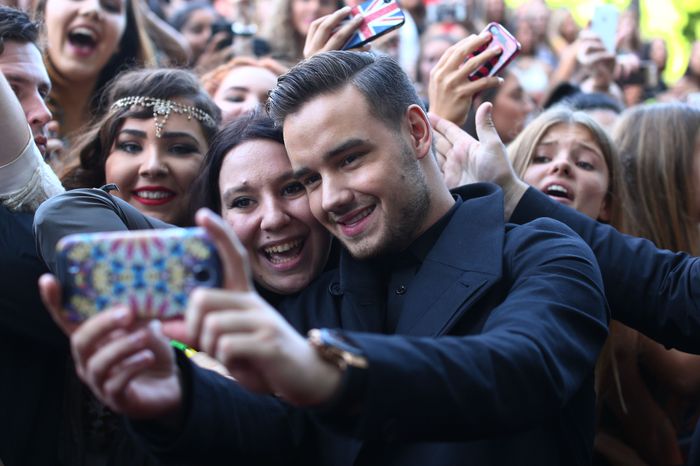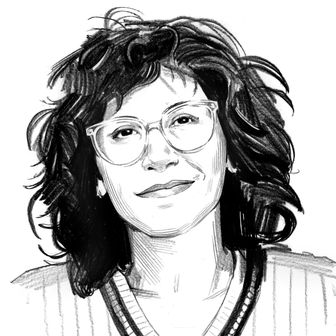
Liam Payne had gone to Argentina to see fellow One Direction bandmate Niall Horan on tour. “It’s been a while since me and Niall have spoken,” Payne said in a Snapchat two weeks ago. “We’ve got a lot to talk about. And I would like to square up a couple of things with the boy. No bad vibes or anything like that.”
The addendum was important: Payne, by his own admission, struggled in his years after One Direction dissolved. To Paynos in the early 2010s, he was the funny, outgoing 1D boy, never afraid to make a fool of himself, who, within the confines of the group’s escalating fame and nonstop touring, came off as the most grounded of the five new pop stars. In recent years, however, he confessed to feeling more resentful of his place in the group, which disbanded in 2016. On Logan Paul’s podcast in 2022, Payne described an argument with an unnamed bandmate that descended into blows, ending with Payne thrown against a wall. In the same conversation, he admitted to a conflicted relationship with Zayn Malik, whose departure from One Direction presaged its infinite hiatus: “There’s many reasons why I dislike Zayn, and there’s many reasons why I’ll always, always be on his side.” He regretted these comments, or he said as much in a YouTube video he posted last summer: “My own frustrations with my own career and where I kind of landed, I took shots at everybody else, which is wrong.”
Payne tragically died on October 16, after falling from the third floor of a hotel in Argentina. But fans had been mourning the loss of the cheeky, friendly kid from the beginning days of the band for years. One Direction broke big when I was in my early 20s and arguably “too old” to care about a group of teenagers, but I was immediately charmed by Payne’s appeals to normalcy. Unlike the other members, who read more like polished archetypes, Payne gave the impression of a realistically mature, buoyant presence (who was credited for writing a significant amount of the group’s hits). He seemed happy confidently belting lines like “Bein’ the way that you are is e-nuh-uh-ough” — though it became clear in recent years that he wasn’t happy, blurring my own memories of that time and Payne’s smiling façade. His ongoing struggles with addiction and eventual disdain for his early fame made it increasingly difficult to square past and present, no matter what the behind-the-scenes videos showed, and no matter how many times his bandmates referred to him as “Daddy Direction” — “the sensible one,” as Louis Tomlinson said in their documentary, This Is Us.
Payne was by no means the only member of the band who spoke candidly about his difficulties both in and outside of his time in the group, but he always appeared to struggle the most visibly. Though he was initially successful in his solo career, his new music lurched along awkwardly as he batted away allegations of biphobia in one of his less-than-great solo tracks. (That a number of grieving fans on Reddit have posted One Direction songs, and not Payne’s solo work, is telling.) He admitted he spent 100 days in a rehab facility in 2023, hoping to curb the alcoholism that had turned him into “someone he didn’t really recognize anymore,” before suffering from a severe kidney infection last fall. Before that, he’d opened up on the podcast Diary of a CEO about the ways in which his early boy-band days were defined by “pills and booze” as well as suicidal ideation. “I don’t blame anyone for this,” he said, “but the best way to secure us in the band was to lock us in our rooms. And, of course, what’s in the room? Minibar.”
In the wake of his death, Payne’s X-Factor peers have been quicker to find fault with others. “There are those who had a responsibility to provide the care and support necessary for the well-being of young artists,” English singer Katie Waissel wrote on X, “but too often, the focus remained on profits rather than the people. This industry has treated talent like commodities, and the negligence of duty of care has once again led to a heart-wrenching loss.”
“I’ve spoken for years about the exploitation and profiteering of young stars and the effects,” Rebecca Ferguson added. “Many of us are still living with the aftermath and the PTSD.”
Agony does not exist in a vacuum, and for all that Payne suffered on his own, he also inflicted damage upon those around him. In the months leading up to his death, his ex-fiancée, Maya Henry, published a novel inspired by her relationship with Payne, which occurred when he was in his late 20s and she was in her late teens. The work of fiction depicts a pop-star love interest named Oliver who is verbally abusive and physically violent, and who, at one point, coerces the protagonist, Mallory, into getting an abortion. For One Direction fans who were teenagers, or even children, during the rise of the band, the fantasy of the “non-threatening boys” in a boy band vanished almost overnight. Every subsequent anecdote that came out of Henry’s novel challenged the nature of Payne’s legacy; even after his death, a number of fans thought first of Henry’s suffering. Payne never publicly responded to the novel, but he remained in the public (and TikTok’s) eye: seeing his mates, traveling the world, spending time with his current girlfriend. And so the tabloids kept covering him. According to the Daily Mail, Henry issued a cease-and-desist letter just days before Payne’s death, accusing him of obsessive contact and “weaponizing” his fans against her.
A year prior, Payne publicly reconnected with Tomlinson, writing in a now-deleted 2023 Instagram post, “I’m so thankful to have you in my life mate I feel so lucky.” If Payne temporarily thought distancing himself from the group was a way forward, he’d changed his mind. After Payne announced his intentions to travel to South America to catch Horan on tour, videos of Payne dancing in the audience circulated the next morning, along with a photo of Payne and Horan together with the caption “Reunited” and a red heart emoji. He returned to being the optimistic face of an actual One Direction reunion, something few others thought possible. Perhaps it’s because Payne once had these paternal instincts within the band that his hope persisted. For a number of ex-boy-banders, the prospect of a bigger reunion is financially motivated, a last resort during bad publicity. But Payne’s desire to keep the boys together, especially after his own difficulties, felt at least partially informed by something deeper. He was flying around the world to see his mates, not the other way around. Even amid controversy, his behavior wasn’t perceived as redemption, exactly, but a step in some more assured direction — if not for him, for the adult 1D fans who were trying to recapture something, too.
When Payne emerged from rehab last year, he tried to further explain to fans the struggles he’d endured in that video from last summer, titled “I’m Back …”, the ellipsis expressing a not-subtle amount of uncertainty. “I kind of had to go away to get better,” he said, to which a commenter replied, “You were here for so many of us during our darkest times and we’re gonna be here if you need us.” But Halsey might have put it best on Tumblr the day after Payne died: “Grief is unsure or complicated when it’s attached to a fond memory or the feeling a person gave you and not tangibly the person themself. I can see many of you are struggling with that right now and I understand.”


